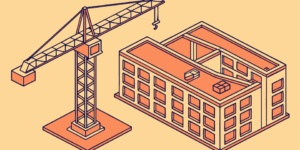It has been a difficult start to 2025, to say the least. While many commercial real estate investors and developers had been looking forward to a better economic environment and lower borrowing costs this year, several policy changes have instead exacerbated market uncertainty and volatility. Now, the Federal Reserve has stalled interest rate cuts, the stock market is posting record losses and economists have increased expectations of a recession this year. Economic and industry outlook reports produced just a few months ago at the beginning of the year—before many of these decisions were made—are now obsolete.
However, macroeconomic fundamentals significantly impact commercial real estate development’s outlook and investment activity, as they affect both demand and supply-side fundamentals. It remains exceedingly important for commercial real estate developers to closely follow emerging trends. Here is a closer look at the changing fundamentals in the first quarter and what they mean for commercial real estate investment moving forward.
Economic Storm Clouds
Despite an optimistic start, economists are now downgrading their economic outlook for the year, with more predicting slower economic growth and an increased risk of a recession. The tariff policy and looming trade war with US trading partners is at the center of the economic fallout. While tariffs could directly impact commercial real estate developers through the higher cost of materials, the economic impact could be even more significant.
Now, S&P predicts a paltry 1.6% GDP growth for the year—down from 2.8% last year—unemployment increasing to 4.6% and only one 25-basis point reduction in interest rates this year. The combination of challenging economic fundamentals and higher borrowing costs will be difficult for developers to navigate. The week the tariffs went into effect, the 10-Year Treasury rate increased to the mid-4% range and the stock market neared a bear market. Core PCE, The Fed’s preferred inflationary measure, climbed to 2.8% in February, and forecasters predict PCE will reach 3.3% this year. Earlier forecasts had pegged PCE at 2.4% this year. Overall, economists are predicting anywhere from a 40% to 50% chance of a recession this year, with some CEOs saying that we are in one now.
Weakening economic fundamentals could impact demand for commercial real estate and hamper rent growth. On the supply side, new commercial real estate developments will find it more difficult to make projects pencil amid higher materials costs, elevated borrowing costs, and reduced proforma expectations on income.
Despite these challenges, developers should continue to pursue opportunities in the market. Developers who are using technology tools like Northspyre have created valuable efficiencies that facilitate budget management and overages, reduce the administrative workload, and stabilize construction schedules. The result helps to cushion the margin and achieve targeted returns. In a market where opportunities feel scarce, these tools will be essential to making a deal work and for gaining a competitive advantage.
Investment Optimism, Despite Uncertainty
At the end of 2024, commercial real estate investment activity rallied in response to rate cuts and improving economic fundamentals—but the start to the year didn’t look as expected. Concerns over tariffs in particular have pushed some investors back to the sidelines. Still, the first quarter has shown signs of continued recovery after a difficult two years of higher interest rates. In February, investment volumes surged 30% across property types. Interestingly, retail and office assets saw the biggest jump in investment volume activity, increasing 105% and 55% respectively. Multifamily, which leads investment activity, grew 7%, marking nine straight quarters of sales increases for the asset class. Industrial sales were flat year-over-year.
Investors have enjoyed cap rate compression in the beginning of the year, indicating stabilizing prices. Retail and industrial have led the trend, with prices growing 5%. Industrial cap rates in particular have fallen, down 13 basis points from last year to an average of 6,29% as demand catches up to supply. Multifamily prices were down 1%, while office assets—which were continuing their recovery—were down 3%. Still, uncertainty continues to characterize the investment environment, where Tim Bodner, U.S. real estate deals leader at PricewaterhouseCoopers, told The Business Journals that the tariffs are creating an environment where “people wait to see what happens before moving forward,” noting that they are eroding confidence across markets.
New Construction Slows Down
Construction activity is slowing down at the beginning of the year, but it isn’t all due to the macroeconomic climate. After several years of record building—particularly in multifamily—development is taking a pause while the market absorbs the new supply. Multifamily is the best example. In the first quarter, 576,700 apartment units were delivered in the US, just below the peak of 585,200 at the same time last year, according to an analysis from Real Page. Going forward, new deliveries will continue to wane through the end of the year and into 2026, falling below historical norms in 2027 and 2028, according to the analysis. Other asset classes, including industrial and office, are also experiencing an oversupply due to suppressed demand related to economic trends, like inflation (in the case of industrial) and work-from-home (in the case of office). The addition of new headwinds, like tariffs and a higher 10-Year Treasury, will likely suppress new development starts through the end of the year.
While the first quarter has certainly brought unexpected new challenges, many commercial real estate investors are reporting healthy activity in the first quarter. Yes, there are headwinds, but the storm hasn’t hit—yet. Tracking trends and investing in technology tools is the best way to ensure you are ready when the weather turns.
Book a Northspyre demo to learn more about how you can control your financials on complex projects and maintain a competitive edge in a difficult market.



